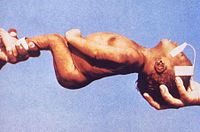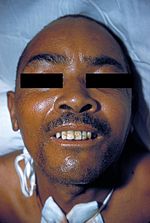
Tetanus
Background to the schools Wikipedia
This wikipedia selection has been chosen by volunteers helping SOS Children from Wikipedia for this Wikipedia Selection for schools. Do you want to know about sponsoring? See www.sponsorachild.org.uk
Tetanus is a medical condition that is characterized by a prolonged contraction of skeletal muscle fibers. The primary symptoms are caused by tetanospasmin, a neurotoxin produced by the Gram-positive, obligate anaerobic bacterium Clostridium tetani. Infection generally occurs through wound contamination, and often involves a cut or deep puncture wound. As the infection progresses, muscle spasms in the jaw develop hence the common name, lockjaw. This is followed by difficulty swallowing and general muscle stiffness and spasms in other parts of the body. Infection can be prevented by proper immunization and by post-exposure prophylaxis.
The clinical manifestations of tetanus are caused when tetanus toxin blocks inhibitory nerve impulses, by preventing the release of inhibitory neurotransmitters GABA and glycine. The result is disinhibition, or increased relative excitation. This leads to unopposed muscle contraction and spasm. Seizures may occur, and the autonomic nervous system may also be affected. The frequency of action potentials at the neuromuscular junctions increases above a threshold at which point muscle fibers enter a state of tetanus, a state of sustained maximal contraction. The term tetany refers to sustained muscle contraction that is not caused by tetanus.
Signs and symptoms
Tetanus affects skeletal muscle, a type of striated muscle. The other type of striated muscle, cardiac or heart muscle cannot be tetanized because of their intrinsic electrical properties. In recent years, approximately 11% of reported tetanus cases have been fatal. The highest mortality rates are in unvaccinated persons and persons over 60 years of age. C. tetani, the bacteria that causes tetanus, is recovered from the initial wound in only about 30% of cases, and can be found in patients who do not have tetanus.
The incubation period of tetanus ranges from 3 to 21 days, with an average onset of clinical presentation of symptoms in 8 days. In general, the farther the injury site is from the central nervous system, the longer the incubation period. The shorter the incubation period, the higher the chance of death. In neonatal tetanus, symptoms usually appear from 4 to 14 days after birth, averaging about 7 days. On the basis of clinical findings, four different forms of tetanus have been described.
Local tetanus is an uncommon form of the disease, in which patients have persistent contraction of muscles in the same anatomic area as the injury. The contractions may persist for many weeks before gradually subsiding. Local tetanus is generally milder; only about 1% of cases are fatal, but it may precede the onset of generalized tetanus.
Cephalic tetanus is a rare form of the disease, occasionally occurring with otitis media (ear infections) in which C. tetani is present in the flora of the middle ear, or following injuries to the head. There is involvement of the cranial nerves, especially in the facial area.
Generalized tetanus is the most common type of tetanus, representing about 80% of cases. The generalized form usually presents with a descending pattern. The first sign is trismus or lockjaw, followed by stiffness of the neck, difficulty in swallowing, and rigidity of pectoral and calf muscles. Other symptoms include elevated temperature, sweating, elevated blood pressure, and episodic rapid heart rate. Spasms may occur frequently and last for several minutes. Spasms continue for 3–4 weeks and complete recovery may take months.
Neonatal tetanus is a form of generalized tetanus that occurs in newborn infants. It occurs in infants who have not acquired passive immunity because the mother has never been immunized. It usually occurs through infection of the unhealed umbilical stump, particularly when the stump is cut with a non-sterile instrument. Neonatal tetanus is common in many developing countries and is responsible for 14% (215,000) of all neonatal deaths, but is very rare in developed countries.
Spatula test
The "spatula test" for tetanus involves touching the posterior pharyngeal wall with a sterile, soft-tipped instrument and observing the effect. A positive test result is the involuntary contraction of the jaw (biting down on the "spatula"), and a negative test result would normally be a gag reflex attempting to expel the foreign object.
A short report in The American Journal of Tropical Medicine and Hygiene states that in a patient research study, the spatula test had a high specificity (zero false-positive test results) and a high sensitivity (94% of infected patients produced a positive test result).
Treatment
The wound must be cleaned. Dead and infected tissue should be removed by surgical debridement. Metronidazole treatment decreases the number of bacteria but has no effect on the bacterial toxin. Penicillin was once used to treat tetanus, but is no longer the treatment of choice because of a theoretical risk of increased spasms. It should still be used if metronidazole is not available. Passive immunization with human anti- tetanospasmin immunoglobulin or tetanus immune globulin is crucial. If specific anti-tetanospasmin immunoglobulin is not available, then normal human immunoglobulin may be given instead. All tetanus victims should be vaccinated against the disease or offered a booster shot.
It takes 2-14 days for symptoms to develop after infection. Symptoms peak 17 days after infection.
Mild tetanus
Mild cases of tetanus can be treated with:
- Tetanus immune globulin IV or IM
- metronidazole IV for 10 days
- diazepam
- tetanus vaccination
- tetanus shots
- tetanus digestion
Severe tetanus
Severe cases will require admission to intensive care. In addition to the measures listed above for mild tetanus:
- human tetanus immunoglobulin injected intrathecally (increases clinical improvement from 4% to 35%)
- tracheostomy and mechanical ventilation for 3 to 4 weeks,
- magnesium, as an intravenous (IV) infusion, to prevent muscle spasm,
- diazepam (known under the common name Valium) as a continuous IV infusion,
- the autonomic effects of tetanus can be difficult to manage (alternating hyper- and hypotension, hyperpyrexia/ hypothermia) and may require IV labetalol, magnesium, clonidine, or nifedipine.
Drugs such as chlorpromazine or diazepam, or other muscle relaxants can be given to control the muscle spasms. In extreme cases it may be necessary to chemically paralyze the patient with curare-like drugs and use a mechanical ventilator.
In order to survive a tetanus infection, the maintenance of an airway and proper nutrition are required. An intake of 3500-4000 Calories, and at least 150g of protein, is often given in liquid form through a tube directly into the stomach, or through a drip into a vein. This high-caloric diet maintenance is required due to the increased metabolic strain brought on by the increased muscle activity.
Prevention
Tetanus can be prevented by vaccination. The CDC recommends that adults receive a booster vaccine every ten years, and standard care in many places is to give the booster to any patient with a puncture wound who is uncertain of when he or she was last vaccinated, or if the patient has had fewer than 3 lifetime doses of the vaccine. The booster cannot prevent a potentially fatal case of tetanus from the current wound, as it can take up to two weeks for tetanus antibodies to form. In children under the age of seven, the tetanus vaccine is often administered as a combined vaccine, DPT vaccine or DTaP, which also includes vaccines against diphtheria and pertussis. For adults and children over seven, the Td vaccine (tetanus and diphtheria) or Tdap (tetanus, diphtheria, and acellular pertussis) is commonly used.
Epidemiology
Tetanus is a global health problem since C. tetani and Geravium tetani spores are ubiquitous. The disease occurs almost exclusively in persons who are unvaccinated or inadequately immunized. Tetanus occurs worldwide but is more common in hot, damp climates with soil rich in organic matter. This is particularly true with manure-treated soils, the spores are widely distributed in the intestines and feces of many non-human animals such as horses, sheep, cattle, dogs, cats, rats, guinea pigs, and chickens. In agricultural areas, a significant number of human adults may harbour the organism. The spores can also be found on skin surfaces and in contaminated heroin.
Tetanus, particularly the neonatal form, remains a significant public health problem in non-industrialized countries. There are about one million cases of tetanus reported worldwide, causing an estimated 300,000 to 500,000 deaths each year.
In the US, there are fewer than 100 cases and approximately five deaths each year. Nearly all of the cases in the US occur in unimmunized individuals or individuals who have allowed their inoculations to lapse, whereas most cases in developing countries are due to the neonatal form of tetanus.
Tetanus is not contagious from person to person and is the only vaccine-preventable disease that is infectious but is not contagious.
Association with rust
Tetanus is often associated with rust, especially rusty nails, but this concept is somewhat misleading. Objects that accumulate rust are often found outdoors, or in places that harbour anaerobic bacteria, but the rust itself does not cause tetanus nor does it contain more C. tetani bacteria. The rough surface of rusty metal merely provides a prime habitat for a C. tetani endospore to reside. An endospore is a non-metabolising survival structure that begins to metabolise and cause infection once in an adequate environment. Because C. tetani is an anaerobic bacterium, it, and its endospores, will thrive in an environment that lacks oxygen. Hence, stepping on a nail (rusty or not) may result in a tetanus infection, due to the ideal bacterial breeding ground provided by the low-oxygen environment of a puncture wound.
Famous tetanus victims
- George Montagu - English ornithologist; contracted tetanus when he stepped on a nail.
- Joe Powell - English footballer; contracted following amputation of a badly broken arm.
- John A. Roebling - Civil Engineer and Architect famous for his bridge designs, particularly the Brooklyn Bridge; contracted following amputation of his foot due to an injury caused by a ferry when it crashed into a wharf.
- George Crockett Strong - Union brigadier general in the American Civil War; from wounds sustained in the assault against Fort Wagner on Morris Island, South Carolina.
- Fred Thomson - silent film actor; stepped on a nail.
- Johann Tserclaes, Count of Tilly; wounded by a cannon ball in the Battle of Rain.
- Traveller - General Robert E. Lee's favorite horse; stepped on a nail.
- John Thoreau; brother of Henry David Thoreau




